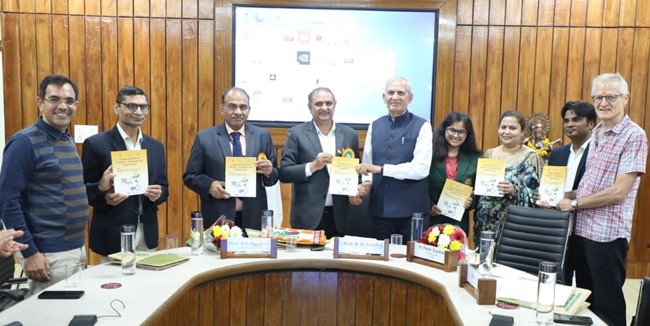
Working towards Sustainable Agricultural Systems in South Asia

Introduction
Working alongside smallholder farmers, the Cereal Systems Initiative for South Asia (CSISA) project has forged partnerships at the state and center levels to bridge the gap between innovation and the adoption of sustainable agricultural systems. In its current phase (2022-2025) in India, CSISA is helping mainstream innovation processes into the programming of national and state institutes through joint extension and research activities, including capacity building initiatives.
Chaudhury Charan Singh Haryana Agriculture University (CCSHAU) is one of Asia’s biggest agricultural universities, located at Hisar in the state of Haryana, India. Together with CCSHAU, CSISA recently initiated a landscape diagnostic survey (LDS) under the university’s rural agricultural work experience (RAWE) program for students graduating with an honors Bachelor of Science in agriculture. The twin objectives of this initiative were to gain an understanding of the existing challenges and opportunities for different cropping systems in Haryana through a bottom-up approach and to prepare students for careers in agriculture by building their practical skills in digital agriculture and big data management.
CSISA and CCSHAU Collaboration
This collaboration between CSISA and CCSHAU aims to address the Sustainable Development Goals (SDGs) by promoting sustainable agricultural practices and empowering future agricultural professionals. By engaging students in real-world research and data collection, this initiative contributes to SDG 4 (Quality Education), SDG 8 (Decent Work and Economic Growth), SDG 9 (Industry, Innovation, and Infrastructure), and SDG 12 (Responsible Consumption and Production).
Landscape Diagnostic Survey
The landscape diagnostic survey was carried out in parts of Sirsa and Hisar districts (for cotton-wheat cropping system), Rewari and Mahendergarh districts (for pearl millet-mustard cropping system), and Panipat, Yamunanagar, and Kurukshetra districts (for rice-wheat cropping system). The survey design was based on farmers’ participatory engagement and the cropping system framework.
- Data Collection: Students collected data from farming households using questionnaires.
- Data Analysis: Students analyzed the collected data using different analytical tools and techniques.
- Publication: The research process, data generated, results, and conclusions were documented in a book entitled “Cropping Systems of Haryana – Challenges and Opportunities”.
Capacity Building and Future Solutions
This initiative provided students with hands-on training and field exposure, enhancing their capacity to design and understand data collection methods, analysis, and management. By gaining insights into farmers’ perspectives and challenges, students are better equipped to contribute to the development of sustainable agricultural solutions in the future.
- RAWE student Muskan, group leader for the rice-wheat cropping system survey, expressed her motivation and improved understanding of farmers’ practices and challenges.
- RAWE student Nilanchal Nishan, group leader for the cotton-wheat cropping system survey, highlighted the importance of understanding the impact of policies and technological advancements on farmers.
- Aman Kumar, who led the pearl millet-mustard cropping system survey, emphasized the value of field exposure in staying updated with trends and prevalent practices in the agricultural sector.
Conclusion
This collaboration between CSISA and CCSHAU demonstrates the importance of integrating sustainable agricultural practices into education and research. By empowering students with practical skills and field exposure, this initiative contributes to achieving the SDGs, particularly SDG 2 (Zero Hunger), SDG 9 (Industry, Innovation, and Infrastructure), SDG 12 (Responsible Consumption and Production), and SDG 17 (Partnerships for the Goals).
Read the Full Publication
SDGs, Targets, and Indicators
1. Which SDGs are addressed or connected to the issues highlighted in the article?
- SDG 2: Zero Hunger
- SDG 4: Quality Education
- SDG 9: Industry, Innovation, and Infrastructure
- SDG 17: Partnerships for the Goals
2. What specific targets under those SDGs can be identified based on the article’s content?
- SDG 2.4: By 2030, ensure sustainable food production systems and implement resilient agricultural practices that increase productivity and production, that help maintain ecosystems, that strengthen capacity for adaptation to climate change, extreme weather, drought, flooding, and other disasters, and that progressively improve land and soil quality.
- SDG 4.4: By 2030, substantially increase the number of youth and adults who have relevant skills, including technical and vocational skills, for employment, decent jobs, and entrepreneurship.
- SDG 9.5: Enhance scientific research, upgrade the technological capabilities of industrial sectors in all countries, in particular developing countries, including, by 2030, encouraging innovation and substantially increasing the number of research and development workers per 1 million people and public and private research and development spending.
- SDG 17.6: Enhance North-South, South-South, and triangular regional and international cooperation on and access to science, technology, and innovation and enhance knowledge sharing on mutually agreed terms, including through improved coordination among existing mechanisms, particularly at the United Nations level, and through a global technology facilitation mechanism.
3. Are there any indicators mentioned or implied in the article that can be used to measure progress towards the identified targets?
- Indicator for SDG 2.4: Adoption of sustainable agricultural practices, increase in productivity, improvement in land and soil quality.
- Indicator for SDG 4.4: Increase in the number of students with relevant skills in digital agriculture and big data management.
- Indicator for SDG 9.5: Increase in research and development workers per 1 million people, increase in public and private research and development spending.
- Indicator for SDG 17.6: Increase in regional and international cooperation on science, technology, and innovation, improvement in knowledge sharing mechanisms.
SDGs, Targets, and Indicators Table
| SDGs | Targets | Indicators |
|---|---|---|
| SDG 2: Zero Hunger | 2.4: By 2030, ensure sustainable food production systems and implement resilient agricultural practices that increase productivity and production, that help maintain ecosystems, that strengthen capacity for adaptation to climate change, extreme weather, drought, flooding, and other disasters, and that progressively improve land and soil quality. | Adoption of sustainable agricultural practices, increase in productivity, improvement in land and soil quality. |
| SDG 4: Quality Education | 4.4: By 2030, substantially increase the number of youth and adults who have relevant skills, including technical and vocational skills, for employment, decent jobs, and entrepreneurship. | Increase in the number of students with relevant skills in digital agriculture and big data management. |
| SDG 9: Industry, Innovation, and Infrastructure | 9.5: Enhance scientific research, upgrade the technological capabilities of industrial sectors in all countries, in particular developing countries, including, by 2030, encouraging innovation and substantially increasing the number of research and development workers per 1 million people and public and private research and development spending. | Increase in research and development workers per 1 million people, increase in public and private research and development spending. |
| SDG 17: Partnerships for the Goals | 17.6: Enhance North-South, South-South, and triangular regional and international cooperation on and access to science, technology, and innovation and enhance knowledge sharing on mutually agreed terms, including through improved coordination among existing mechanisms, particularly at the United Nations level, and through a global technology facilitation mechanism. | Increase in regional and international cooperation on science, technology, and innovation, improvement in knowledge sharing mechanisms. |
Behold! This splendid article springs forth from the wellspring of knowledge, shaped by a wondrous proprietary AI technology that delved into a vast ocean of data, illuminating the path towards the Sustainable Development Goals. Remember that all rights are reserved by SDG Investors LLC, empowering us to champion progress together.
Source: cimmyt.org

Join us, as fellow seekers of change, on a transformative journey at https://sdgtalks.ai/welcome, where you can become a member and actively contribute to shaping a brighter future.





